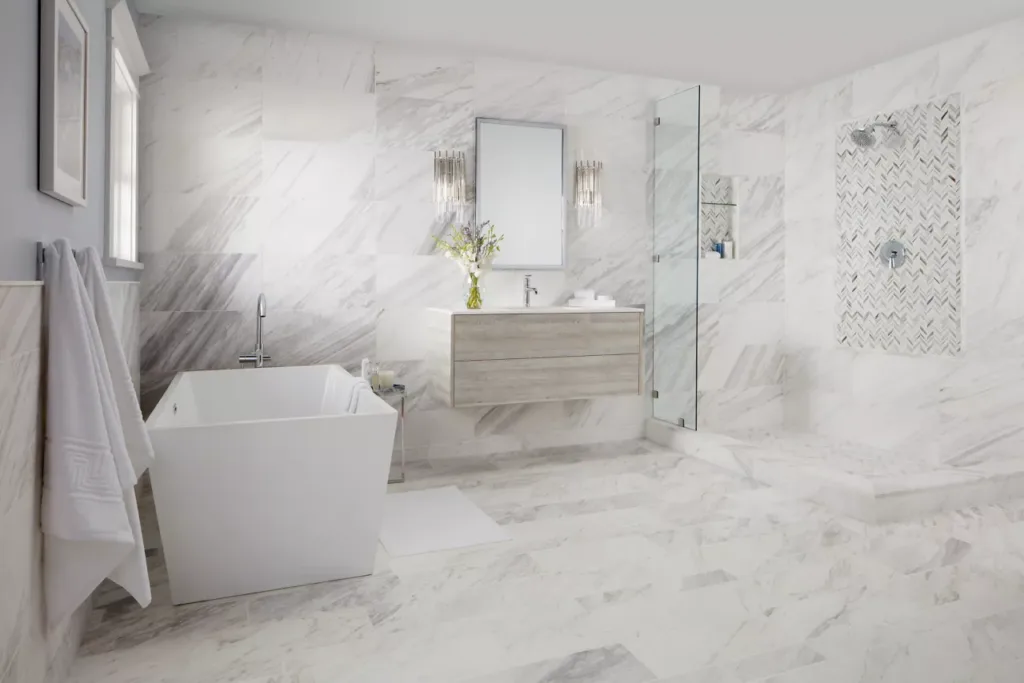How to Choose the Right Tiles for Your Bathroom: A Comprehensive Guide
Choosing the perfect tiles for your bathroom is one of the most exciting parts of a bathroom renovation or design project. Tiles set the tone for your space, influencing everything from the atmosphere to the functionality of the room. With so many materials, colors, shapes, and patterns available, selecting the right tiles can be overwhelming. This guide will help you navigate the tile selection process, ensuring you make choices that are both practical and stylish.
1. Consider the Size of the Bathroom
The size of your bathroom plays a significant role in determining the types of tiles you should use. In smaller bathrooms, lighter tiles, such as white, light gray, or pastel colors, can make the space feel more open and airy. Large-format tiles can reduce the number of grout lines and make the space appear larger. Additionally, when using large tiles, ensure the room is well-lit to avoid making it feel boxed in.
In larger bathrooms, you have more flexibility to play with bolder designs, such as darker tones or patterned tiles, without overwhelming the space. Larger tiles can also work well in large bathrooms to create a seamless, luxurious look, especially if you’re using stone or marble tiles.
2. Choose the Right Tile Material
Tile materials vary widely in terms of appearance, durability, and maintenance. Some common tile materials for bathrooms include:
- Ceramic and Porcelain Tiles: These are the most popular options for bathroom walls and floors. They are durable, water-resistant, and easy to clean. Porcelain tiles, in particular, are denser and less porous than ceramic, making them ideal for wet areas like showers and floors.
- Natural Stone Tiles: Materials like marble, granite, and slate bring elegance and luxury to the bathroom. However, natural stone tiles require more maintenance than ceramic or porcelain, as they need to be sealed regularly to protect them from moisture and stains.
- Glass Tiles: These tiles are sleek, modern, and available in a variety of colors and textures. Glass tiles are often used for accents, backsplashes, or feature walls. They reflect light, making a bathroom feel brighter and more spacious. However, they can be more prone to scratching and are usually more expensive.
- Vinyl Tiles: Vinyl tiles are budget-friendly and water-resistant, making them a great option for budget-conscious renovations. While they may not offer the same upscale appearance as natural stone or ceramic tiles, modern vinyl tiles come in a wide range of styles and can even mimic the look of wood or stone.
3. Tile Patterns and Layout
The layout of your tiles can dramatically affect the overall appearance of your bathroom. Some popular tile patterns include:
- Subway Tile: Classic and timeless, subway tiles are rectangular and are commonly laid in a brick pattern. They work well in almost any bathroom style, from modern to traditional.
- Chevron and Herringbone: These patterns feature angled, zigzag shapes that add a sense of movement to the space. They work especially well for bathroom floors or accent walls.
- Mosaic Tiles: These small, square tiles are often used to create intricate designs or vibrant accent areas. Mosaic tiles are a great option for showers, feature walls, or around bathtubs, where their detail can shine.
- Large Format Tiles: For a sleek, modern look, large-format tiles with minimal grout lines can make the bathroom feel more expansive and sophisticated.
4. Durability and Maintenance
Your bathroom tiles should be durable enough to withstand the daily wear and tear of a wet, high-traffic area. Porcelain and ceramic tiles are highly resistant to moisture, making them the top choice for bathrooms. Consider the texture of the tiles as well—smooth tiles are easier to clean, while textured tiles may provide extra grip for wet areas like showers.
It’s important to think about the maintenance involved with the material. Natural stone tiles, for example, require sealing and more careful upkeep than ceramic tiles, which are relatively low-maintenance.
5. Style and Aesthetic
Your tiles should reflect the overall style of your bathroom. Whether you prefer a sleek, modern design, a cozy, rustic feel, or a classic, timeless space, the right tiles can help bring your vision to life. Choose colors and patterns that complement the other elements of your bathroom, such as your vanity, fixtures, and lighting.
For a modern look, consider neutral tones and geometric patterns. For a more traditional aesthetic, natural stone or subway tiles in white or soft colors can add elegance. You can also mix different textures, such as glossy tiles paired with matte finishes, to create depth and interest in the space.









Add comment